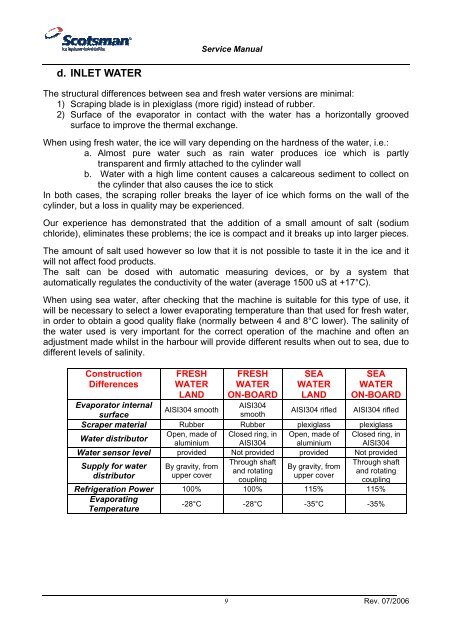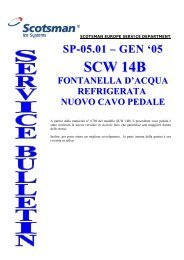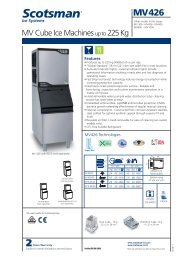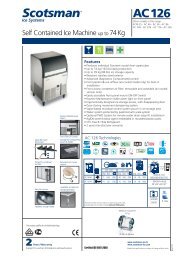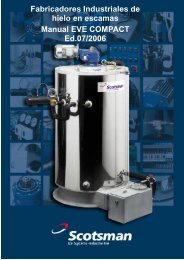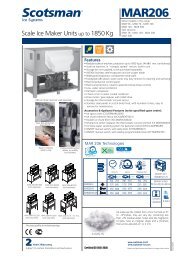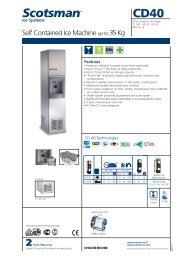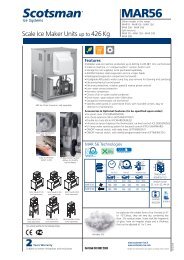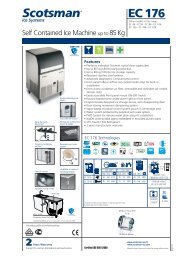Ed. 07/2006 - Scotsman
Ed. 07/2006 - Scotsman
Ed. 07/2006 - Scotsman
You also want an ePaper? Increase the reach of your titles
YUMPU automatically turns print PDFs into web optimized ePapers that Google loves.
Service Manual<br />
d. INLET WATER<br />
The structural differences between sea and fresh water versions are minimal:<br />
1) Scraping blade is in plexiglass (more rigid) instead of rubber.<br />
2) Surface of the evaporator in contact with the water has a horizontally grooved<br />
surface to improve the thermal exchange.<br />
When using fresh water, the ice will vary depending on the hardness of the water, i.e.:<br />
a. Almost pure water such as rain water produces ice which is partly<br />
transparent and firmly attached to the cylinder wall<br />
b. Water with a high lime content causes a calcareous sediment to collect on<br />
the cylinder that also causes the ice to stick<br />
In both cases, the scraping roller breaks the layer of ice which forms on the wall of the<br />
cylinder, but a loss in quality may be experienced.<br />
Our experience has demonstrated that the addition of a small amount of salt (sodium<br />
chloride), eliminates these problems; the ice is compact and it breaks up into larger pieces.<br />
The amount of salt used however so low that it is not possible to taste it in the ice and it<br />
will not affect food products.<br />
The salt can be dosed with automatic measuring devices, or by a system that<br />
automatically regulates the conductivity of the water (average 1500 uS at +17°C).<br />
When using sea water, after checking that the machine is suitable for this type of use, it<br />
will be necessary to select a lower evaporating temperature than that used for fresh water,<br />
in order to obtain a good quality flake (normally between 4 and 8°C lower). The salinity of<br />
the water used is very important for the correct operation of the machine and often an<br />
adjustment made whilst in the harbour will provide different results when out to sea, due to<br />
different levels of salinity.<br />
Construction<br />
Differences<br />
FRESH<br />
WATER<br />
LAND<br />
FRESH<br />
WATER<br />
ON-BOARD<br />
AISI304<br />
smooth<br />
SEA<br />
WATER<br />
LAND<br />
SEA<br />
WATER<br />
ON-BOARD<br />
Evaporator internal<br />
surface<br />
AISI304 smooth<br />
AISI304 rifled AISI304 rifled<br />
Scraper material Rubber Rubber plexiglass plexiglass<br />
Water distributor<br />
Open, made of Closed ring, in Open, made of Closed ring, in<br />
aluminium AISI304 aluminium AISI304<br />
Water sensor level provided Not provided provided Not provided<br />
Through shaft<br />
Through shaft<br />
Supply for water By gravity, from<br />
By gravity, from<br />
and rotating<br />
and rotating<br />
distributor upper cover<br />
upper cover<br />
coupling<br />
coupling<br />
Refrigeration Power 100% 100% 115% 115%<br />
Evaporating<br />
Temperature<br />
-28°C -28°C -35°C -35%<br />
9 Rev. <strong>07</strong>/<strong>2006</strong>


